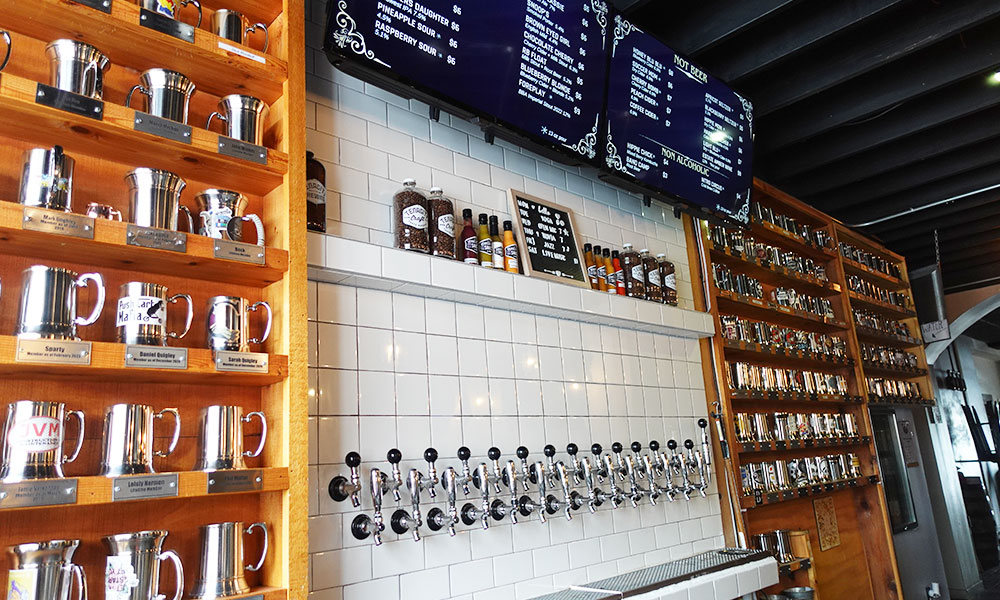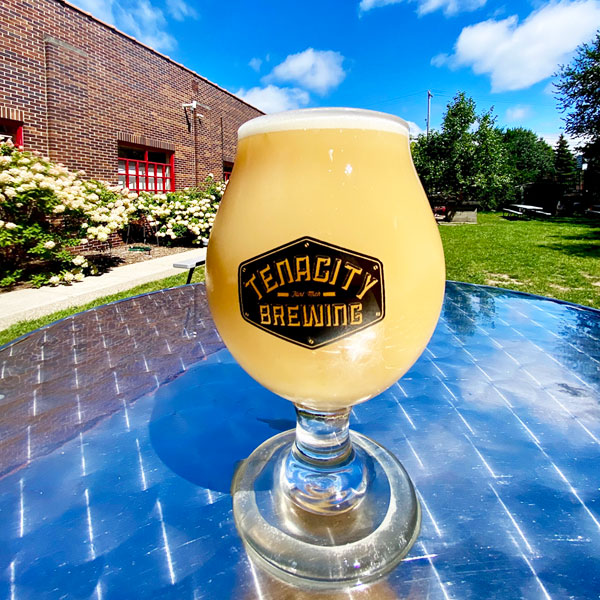
[ad_1]
“At all times provide at the least a glass of water to your visitors.” As a toddler of immigrants, I understood this straightforward maxim to be a baseline for good internet hosting. I discovered secondhand that India was a spot the place sudden guests and open-door insurance policies are the norm. I couldn’t have anticipated how these methods of transferring by way of the world would translate inside my skilled life within the craft beer business.
I reduce my enamel bartending in Seattle’s Ballard Brewery District, the place transformed warehouses and a lingering spirit of maritime tradition colour the neighborhood with an approachable model of grittiness. A spectrum of individuals, from faculty college students to vacationers, brewery hop (or cycle) in an try to finish their Ballard Brewed Passport. Providing a glass of water on the sight of completely happy, flushed faces felt instinctual.
Entry to water is each a fundamental human proper and a universally understood signal of hospitality. As I dove into the origins of my discovered conduct, I started to wonder if water service at eating places and bars in America may very well be traced to cross-cultural water customs. Water (normally) prices nothing to prospects, however the unstated situation for present in third locations is that you could purchase one thing. What occurs when the third place not matches a visitor’s way of life? Within the context of craft brewery taprooms, water can play a job in creating the sense of belonging and security intrinsic to constructing hospitable neighborhood areas.
Widespread Useful resource, Not Commodity
In a 2005 paper for the Yale Journal of Legislation & Humanities, environmental coverage knowledgeable James Salzman describes historical and indigenous water-sharing practices throughout 4 totally different continents. Regardless of totally different administration approaches, “water is regarded in the beginning as a typical property useful resource, not as a commodity.”
So-called “Proper of Thirst” is noticed in conventional Jewish and Islamic water legislation: Free entry to consuming water for neighborhood members and outsiders was acknowledged and prioritized over agricultural and home water use. It was thought of sacrilegious to squander a divine present from God.

“Sharing norms” in Zimbabwe are cautionary: Homeowners of personal water sources defend towards literal—and religious—poisoning by being open for communal consuming. In Bihar, India, solely higher caste members might make use of sacred water sources; decrease castes drew from separate sources to keep away from “cross-pollution.” In each cultures there’s apparent regard for sharing in occasions of water shortage, though this conduct appears to be rooted in worry. Australia is the world’s driest inhabited continent, and “all the time ask” guidelines inside Aboriginal communities respect information of water sources as mental property. Virtually no one is turned away.
In Consuming Water: A Historical past, Salzman explains the very human origins of the inclination to share: “Any traveler in an arid area might foresee a scenario the place she or he may want water from strangers for survival. A rule that gave water to these in want may very properly in the future profit them or their tribal members.”
Belonging, With out Beer
We’re all simply in search of a spot to land. Whether or not they’re a part of our neighborhood or visiting us from afar, our visitors come to us thirsty—and the craft beer business is altering. Sober-curious bars are popping up throughout NYC, and Gen Z is reevaluating its relationship with alcohol. Tacoma, Washington’s E9 Brewing acknowledged this shift and put in a kegerator of free glowing water in June 2020. The manufacturing crew and bartenders have been early imbibers, however their prospects didn’t catch on instantly. Round that point, head brewer Shane Johns had in the reduction of his beer consumption, too: “What we discovered was that folks most well-liked a taste. That’s extra of a La Croix phenomenon.”
Beer is an acquired style. As a taproom supervisor, I’m conversant in how unique craft beer areas will be. I’ve misplaced depend of what number of occasions I’ve greeted somebody on the bar who halfheartedly begins with, “I’m not normally a beer drinker.” This type of taproom visitor is normally in search of a strategy to really feel included alongside the beer lover they’ve accompanied. Whether or not prospects have a gluten allergy, don’t like the flavour, or just aren’t conversant in the panorama of beer types, constructing inclusive taprooms isn’t as simple as eradicating the alcohol. Flavored water is a made-in-house possibility for visitors who could not sometimes “belong” within the taproom: pregnant individuals, youngsters, and Muslim mates, to call a couple of.
In January 2023, E9 launched Tahoma Hop Water in two flavors, lemon and lime. A yr later, it now produces three further flavors: passionfruit, grapefruit, and pineapple. Sharing a reputation with the indigenous Puyallup Tribe’s title for iconic Mount Rainier, “Mom of Waters” is made with Mosaic hops from the Yakima Valley and smooth, chuggable water that flows from the mountain by way of the remainder of the Inexperienced River Watershed. It’s an extremely accessible beverage.
“My five-year-old daughter drinks it,” says Johns.
Johns famous that hop water shouldn’t be flying off their cabinets, however it’s straightforward to make. It additionally appears to create a welcoming ambiance for everybody, from the fellows who’re “outdated within the beer recreation” and people visitors who simply wish to hang around with their mates. Some stick solely to hop water. It doesn’t must be a bestseller to fulfill prospects the place they’re.
“I believe individuals really feel awkward in the event that they don’t have one thing in entrance of them once they’re at a brewery… Possibly now they’re going to have a hop water in between two IPAs.”
Water and Tenacity
It’s telling that in a e book about consuming water, Salzman calls out alcohol as a traditionally trusted different within the absence of protected water sources: “In lots of cultures, the best technique to keep away from unsafe consuming water has been to keep away from water altogether.”

I puzzled: Did pub tradition emerge in individualistic (versus collectivistic) cultures, in locations the place hospitality norms weren’t so clearly outlined and vacationers nonetheless wanted protected locations to retire? Craft breweries are all over the place now. When I’m touring to a brand new place, I make it some extent to go to at the least one as a result of it helps me really feel immersed in an area tradition. In October 2020, circumstances in my private life introduced me to “Car Metropolis”— Flint, Michigan—and Tenacity Brewing.
Here’s a metropolis with true grit: A public well being emergency unfolded just some months after Tenacity opened in 2014. The bulk-Black metropolis’s consuming water turned lead-contaminated when authorities officers switched its water supply to the Flint River. Tenacity co-owner Robb Klaty and his staff noticed wild swings in pH early on: “We started trucking in water from a neighboring neighborhood for months whereas it bought sorted.”
Flint’s solely brewery was prepared to fulfill the neighborhood’s water wants. Most trendy brewers use reverse osmosis to regulate a water’s mineral profile and begin with a clean canvas for taste. This course of additionally removes lead contaminants. Common impartial lab assessments, authorities assessments, and in-house assessments weren’t sufficient to assuage the general public worry that emerged on the time.
“We did provide our examined and verified water free to the neighborhood on the time and checked out a number of concepts to assist, however the unimaginable quantity of bottled water coming in from exterior of Flint together with the skepticism about something related to Flint—even when it was examined—left us within the place as a recipient of generosity from the skin that we have been grateful for,” Klaty says.
I’m positive that I’m a part of a majority of taproom managers who consider their companies as neighborhood areas. I ponder what I might do if my neighborhood was so shaken within the face of a disaster that my assist couldn’t attain them. The place would we go from there? I recall a quiet, tentative temper on the day I visited Tenacity. Public areas have been simply reopening after COVID-19 stay-at-home measures.
“Individuals who have been right here for a while have seen loads of ups and downs,” Klaty says. “There’s a feeling that there’s all the time some problem now or across the nook … that’s life.”
‘A Glass of Water Doesn’t Price Something’
Thirst is a tangible want. People can solely survive with out water for about three days. How lengthy are you able to go with out seeing one other individual? Maybe by seeing one another, we’re higher in a position to see ourselves. Water’s emergence as a hospitality device seems like some type of self-preservation: Assembly these small wants for others will help us to start to make which means of our personal humanity.
I started this piece by looking for my grandmother’s phrases. I requested her concerning the origins of the hospitality follow she instilled in me, hoping for solutions. Upon my insistent questioning, she illustrated what was apparent to her (and imprecisely translated right here):
“We give visitors honor once they come to our residence … by doing so, each our honor and their honor will increase. If somebody comes, we invite them in and that prices us nothing. Talking doesn’t price something, sitting doesn’t price something, giving them a glass of water doesn’t price something. We ask for nothing, but when they arrive, we invite them in with love.”
CraftBeer.com is absolutely devoted to small and impartial U.S. breweries. We’re printed by the Brewers Affiliation, the not-for-profit commerce group devoted to selling and defending America’s small and impartial craft brewers. Tales and opinions shared on CraftBeer.com don’t indicate endorsement by or positions taken by the Brewers Affiliation or its members.
[ad_2]